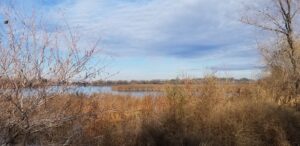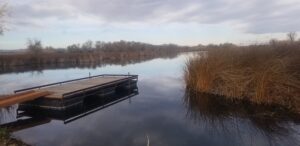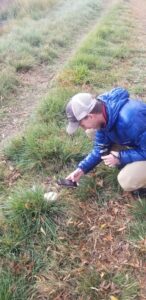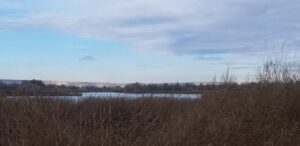As the Snake River begins to reach the Magic Valley, a series of springs fed by the Eastern Snake Plain Aquifer (ESPA) feed the river from the dark basalt walls lining its edge. These springs provide life to the surrounding area and can be viewed and experienced at fish hatcheries across the region, within Thousand Springs State Park, and amongst places such as the well-known and beloved Hagerman Wildlife Management Area (WMA).

The Hagerman Wildlife Management Area and Hagerman Fish Hatchery sit on 882 acres and surround lush wetlands and spring-fed ponds that provide refuge to upwards of 50,000 waterfowl over the winter months. Birdwatchers flock to the area to embrace the abundance of avian species during the colder parts of the year. With fall setting in, ICL staff decided to head into the Hagerman WMA to explore the abundant wildlife that calls this area home.
We arrived at Hagerman Valley just after sunrise, eager to explore this critical habitat. The robust smell of damp soil and flourishing vegetation met us with the vivacious clucks, honks, and quacks curated by seasonal avian residents. We quickly grabbed our binoculars and spotting scope and began a leisurely hike along the trail.

A visit to Riley Pond was first on the agenda. Without our birdwatching silence fully engaged, we scared the birds from the water. This sudden flight movement resulted in a loud thunk caused by hundreds of waterfowl initiating flight simultaneously. With our first attempt at birdwatching behind us, we approached the next area with quiet ease. Across the water, a large flock of American coots were swimming while buffleheads rose from foraging under the water’s surface. Neighboring ponds were full of noisy mallard hens with drakes in hot pursuit to pair up before winter arrives. As we passed Anderson Ponds, we stopped and watched two stunning, large cormorants sunbathing to dry their wings.

We continued our stroll past Bass Lakes, dreaming of throwing fly or lure into the glassy water and making sure each step, sound, and movement went undetected. We stopped from time to time to take in the copious amounts of thriving birds: their landing and take-off techniques, diving, and communicating. We were able to identify some birds instantaneously, while others required us to take in every detail to determine which species we were spotting. For species we struggled to identify, we evaluated every aspect of the unknown bird: colors, shape, beak, eye color and size, and behavior.
The visuals of the landscape were clearly before us, but there was another aspect of birdwatching that we embraced, and that is the auditory soundscape surrounding us. The calls surrounded us from the water, the land, and the vegetation. The sounds of mallard hens and their high-pitch series quack, quack, quack were heard in every direction. And then some sounds caught us off-guard and stopped us in our tracks. Audacious and guttural grunts of double-crested cormorants and the rasping alarm croaks of a great blue heron began emerging from the riparian vegetation. With every turn, every body of water and piece of land surprised us with the calls that greeted our arrival.

The soundscape did not stop at eye level. Overhead it continued as large V formations of Canada geese passed over, announcing their presence with high-pitched repeated honking. And then there were the sporadic honks from the occasional flock of snow geese en route to their winter destination. At one point, a Bald Eagle sat stoic and silent high in tree foliage; and soon after we heard the chattering of an osprey overhead. The soundscape of the WMA kept our minds busy as we scoured the areas to decipher which call was from which bird.
The entire wooded and grassy stroll amongst glistening bodies of water allowed us to witness an abundance of life. The springs that provide the water for this area create vital habitats, promote diverse ecosystems, and offer abundant recreational opportunities for people of all ages and backgrounds. It is no wonder that the Shoshone and Bannock tribes had semi-permanent camps nearby to utilize during the once annual chinook and steelhead migrations. And I think as we stood there, taking in the scenery, we were not surprised that some weary Oregon Trail pioneers decided to end their journey and homestead, creating the Hagerman Valley as we know it today. These springs provide life and have since their creation.
In ICL’s third annual Magic Valley Groundwater Report, we found that springs, such as those that flow into the Hagerman Wildlife Management Area and Hagerman Fish Hatchery, have elevated amounts of phosphorus, likely due to agricultural activities in the area. Areas such as Hagerman Wildlife Management Area thrive because of the historically clean, cold water that the Eastern Snake Plain Aquifer provides. Aquifer contamination and mismanagement can negatively impact our community’s drinking water and potentially affect the wildlife that depends on these areas. Anglers, birdwatchers, hikers, hunters, and picnickers all benefit from natural areas like this. Join us and demand that local, state, and federal policymakers restore water quality in the Snake River and the surrounding aquifer.
